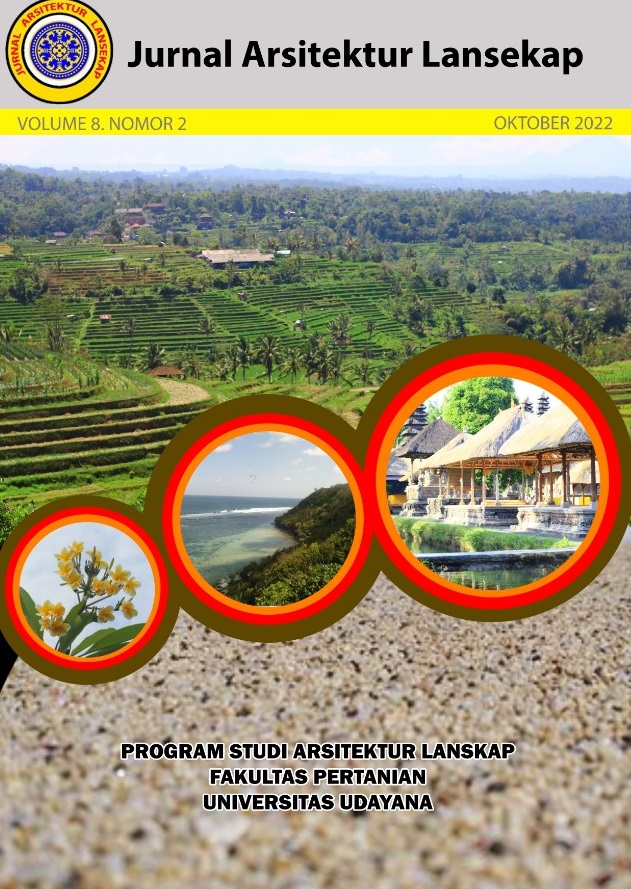Evaluasi jenis dan penataan tanaman median jalan Sunset Road, Kuta untuk keselamatan pengendara
Abstract
This study aims to evaluate the type and arrangement of plants on the median of Sunset Road with a length of 1,561 m which is divided into 7 segments based on road characteristics and driver safety criteria. The survey method with a qualitative descriptive analysis approach and data collection techniques in the form of observation, interviews and literature study were used in this study. The results of the evaluation showed that 12.5% of plant species were categorized as unsuitable and potentially dangerous to motorists, 50% were suitable and 37.5% were very suitable to be planted on the Sunset Road median. Plants in the median of the road should have more than 1 function, based on each function, 93.8% of plants on Sunset Road have a directing function, 62.5% have a function as a vehicle light blocking, 56.5% have a separator function and 18.8% of plants have a safety function. Completeness of plant composition in terms of leaf texture, height and color in each segment ranged from 56-89%. In addition, improper arrangement was also found in several segments, especially segments 2-5. It can be concluded that there is a mismatch of species and plant arrangement in the median of Sunset Road in terms of the driver safety criteria used in this study.
Downloads
References
Arikunto, Suharsimi. (2015). Penelitian Tindakan Kelas (Edisi Revisi).Bumi Aksara. Jakarta.
Carpenter, P. L., T. D. Walker, F. O Lanphear. (1975). Plants in the Landscape. WH Freeman & Co.
Hakim, R., & Utomo, H. (2008). Komponen Perancangan Arsitektur Lansekap: prinsip-unsur dan aplikasi desain. PT Bumi Aksara.
Handayani, Putri. (2016). Persepsi Risiko Keselamatan Berkendara Berdasarkan Paradigma Psikometri Pada Pengguna Kendaraan Roda Dua. Indonesian of Health Information Management Journal (INOHIM), 4(2), 37-42.
Jumain., Asmawati, H. Nunuk. (2017). Uji Efek Analgetik Ekstrak Etanol Daun Zigzag (Euphorbia tithymaloides) Terhadap Mencit Jantan (Mus musculus). Media Farmasi, vol. XIII. No. 2.
Kementerian Pekerja Umum dan Perumahan Rakyat. (1996). Tata Cara Perencanaan Teknik Lanskap Jalan. Departemen Pekerjaan Umum, Direktorat Jendral Bina Marga. Jakarta.
Kementerian Pekerja Umum dan Perumahan Rakya. (2008). Peraturan Menteri Pekerjaan Umum No. 5 Tahun 2008 tentang Pedoman Penyediaan dan Pemanfaatan Ruang Terbuka Hijau di Kawasan Perkotaan. Departemen Pekerjaan Umum. Jakarta.
Kementerian Pekerjaan Umum dan Perumahan Rakyat. (2012). Peraturan Menteri Pekerjaan Umum No. 5 Tahun 2012 tentang Pedoman Penanaman Pohon pada Sistem Jaringan Jalan. Menteri Pekerjaan Umum dan Perumahan Rakyat. Jakarta.
Kementerian Pekerja Umum dan Perumahan Rakyat. (2017). Tata Cara Perencanaan Geometrik Persimpangan Sebidang. Departemen Permukiman dan Prasarana Wilayah. Jakarta.
Lawalata, G. M. (2011). Perencanaan Lansekap Jalan Perkotaan. Kementerian Pekerjaan Umum. Bandung.
Lerebulan, M. F. A., Asmiwyati, I. G. A. A. R., & Sukewijaya, I. M. (2020). Evaluasi Jenis dan Pola Penanaman Tanaman Di Median Jalan Ir. Soekarno Kota Saumlaki, Maluku Tenggara Barat. Jurnal Arsitektur Lansekap, 139–148.
Morrisan, M A. (2012). Metode Penelitian Survei. Kencana. Jakarta
Pradipta, I. A., S. M. Sarwadana, N. L. M. Pradnyawathi. (2018). Persepsi Dan Preferensi Masyarakat Terhadap Taman Rekreasi Bantaran Sungai Loloan Sanur. Jurnal Arsitektur Lansekap, 194–201.
Rahman, Arief, J. Najoan, M. G. M. Polii. (2015). Evaluasi Aspek Fungsi Tanaman Pada Lanskap Jalan Kampus Universitas Sam Ratulangi. In COCOS. Vol. 6.
Rizka, J. (2019). Evaluasi Tata Hijau Jalur Hijau Jalan Kota Pekanbaru. S.Arsl. Skripsi (tidak dipublikasikan). Institut Pertanian Bogor.
Sugiyono, P. (2004). Metode Penelitian Kombinasi. CV Alfabeta. Bandung.
Wahyudi, Imam, D. K. D. Sinaga, L. B. Jasni. (2014). “Pengaruh Jarak Tanam Terhadap Pertumbuhan Pohon Dan Beberapa Sifat Fisis-Mekanis Kayu Jati Cepat Tumbuh. Jurnal Ilmu Pertanian Indonesia 19 (3): 204–10.
Yasmine, P. A., dan Wicaksono, K. P. (2019). Analisis Tingkat Kenyamanan dan Vegetasi Ruang Terbuka Hijau Taman Singha Merjosari. PLANTROPICA: Journal of Agricultural Science, 3(2), 149–155.

This work is licensed under a Creative Commons Attribution-ShareAlike 4.0 International License.
An author who publishes in the Jurnal Arsitektur Lansekap (JAL) agrees to the following terms:
- Author retains the copyright and grants the journal the right of first publication of the work simultaneously licensed under the Creative Commons Attribution-ShareAlike 4.0 License that allows others to share the work with an acknowledgement of the work's authorship and initial publication in this journal
- Author is able to enter into separate, additional contractual arrangements for the non-exclusive distribution of the journal's published version of the work (e.g., post it to an institutional repository or publish it in a book) with the acknowledgement of its initial publication in this journal.
- Author is permitted and encouraged to post his/her work online (e.g., in institutional repositories or on their website) prior to and during the submission process, as it can lead to productive exchanges, as well as earlier and greater citation of the published work (See The Effect of Open Access).
Read more about the Creative Commons Attribution-ShareAlike 4.0 Licence here: https://creativecommons.org/licenses/by-sa/4.0/.







